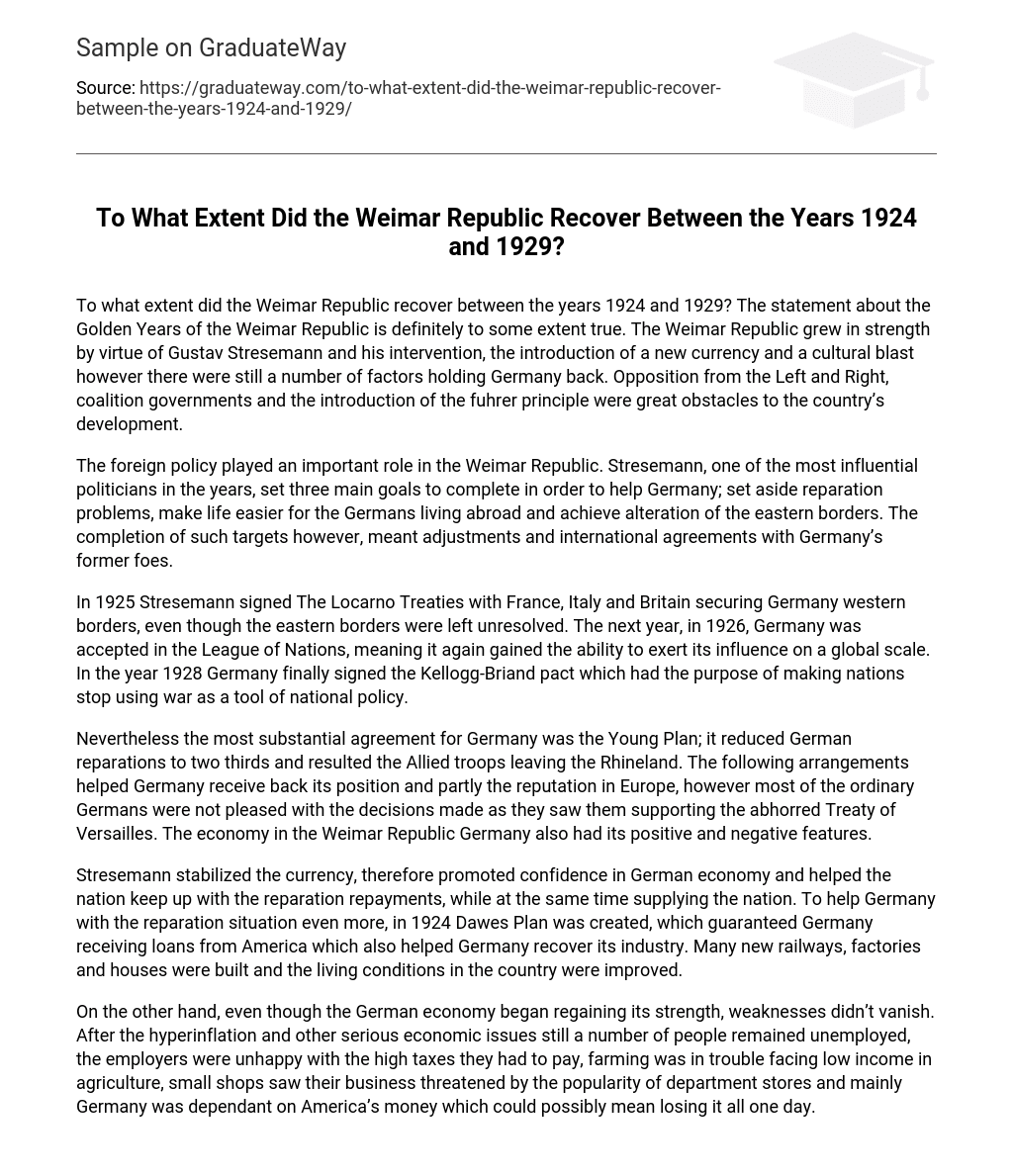To what extent did the Weimar Republic recover between the years 1924 and 1929? The statement about the Golden Years of the Weimar Republic is definitely to some extent true. The Weimar Republic grew in strength by virtue of Gustav Stresemann and his intervention, the introduction of a new currency and a cultural blast however there were still a number of factors holding Germany back. Opposition from the Left and Right, coalition governments and the introduction of the fuhrer principle were great obstacles to the country’s development.
The foreign policy played an important role in the Weimar Republic. Stresemann, one of the most influential politicians in the years, set three main goals to complete in order to help Germany; set aside reparation problems, make life easier for the Germans living abroad and achieve alteration of the eastern borders. The completion of such targets however, meant adjustments and international agreements with Germany’s former foes.
In 1925 Stresemann signed The Locarno Treaties with France, Italy and Britain securing Germany western borders, even though the eastern borders were left unresolved. The next year, in 1926, Germany was accepted in the League of Nations, meaning it again gained the ability to exert its influence on a global scale. In the year 1928 Germany finally signed the Kellogg-Briand pact which had the purpose of making nations stop using war as a tool of national policy.
Nevertheless the most substantial agreement for Germany was the Young Plan; it reduced German reparations to two thirds and resulted the Allied troops leaving the Rhineland. The following arrangements helped Germany receive back its position and partly the reputation in Europe, however most of the ordinary Germans were not pleased with the decisions made as they saw them supporting the abhorred Treaty of Versailles. The economy in the Weimar Republic Germany also had its positive and negative features.
Stresemann stabilized the currency, therefore promoted confidence in German economy and helped the nation keep up with the reparation repayments, while at the same time supplying the nation. To help Germany with the reparation situation even more, in 1924 Dawes Plan was created, which guaranteed Germany receiving loans from America which also helped Germany recover its industry. Many new railways, factories and houses were built and the living conditions in the country were improved.
On the other hand, even though the German economy began regaining its strength, weaknesses didn’t vanish. After the hyperinflation and other serious economic issues still a number of people remained unemployed, the employers were unhappy with the high taxes they had to pay, farming was in trouble facing low income in agriculture, small shops saw their business threatened by the popularity of department stores and mainly Germany was dependant on America’s money which could possibly mean losing it all one day.
So of course the economic situation in the Weimar Republic wasn’t flawless but it certainly improved and managed to almost catch up with the rest of Europe. The political problems in the Weimar Republic were more complicated. German politics were rather unstable and no party was able to win the majority of seats in the Reichstag. The Social Democrats were as always committed to the republic though other parties saw them as too revolutionary and suspicious. As all the governments were coalitions the system did not work well and became even more unstable.
Parties such as the Communists and Nazis, which had seats in the Reichstag, wished to overthrow the Weimar Republic, which wasn’t making anything simpler and Hindenburg was elected as president what could possibly mean the return of old Germany. During this time the number of extremist parties stayed small, which could be called a relief and the politics generally were slowly stabilizing. The Golden Age of the Weimar Republic saw many changes to the cultural life of Germany. There was a resurgence of creative flair that made Berlin the centre of art and culture.
Many new movements such as Expressionism and Modernism shaped the culture of the time which was represented in literature, art, architecture, cinema and theater created. New paintings were done so ordinary people had a chance of understanding them and art in general expressed feelings and emotions in works. Literature also gained great success, often inspired by First World War and writers such as Thomas Mann won Noble Prizes for their brilliant writing. Popularity also came across theaters and cinema. Like in art, Berlin became the world leader in cinema enjoying its golden age with great directors like Fritz Lang and Joseph von Sternberg.
Germany’s capital also became famous for its nightlife, where new clubs and cabarets were shocking and sex and homosexuality were openly discussed topics. This was definitely a great change of lifestyle for many people although others saw Berlin as a disastrous city of scandalous attitudes. So even though even other countries saw Berlin as a successful city of nightlife, great culture a free lifestyle most of Germany was too conservative to accept such freedom and desired to keep traditional German values. The Weimar Republic certainly recovered between the years 1924 and 1929 to some extent.
For a long time after the Great War Germany faced numerous difficulties and was considered a slowly developing country but the amount of hard work and successes that followed made it slowly stable and prosperous. Of course Germany was still vulnerable in its economy and politics but the Dawes Plan was a great help to German finances, large businesses and industries were rapidly growing, culture greatly developed and people enjoyed new freedoms and lifestyle. In these years Germany hadn’t reached perfection but it definitely recovered from its worst times.





